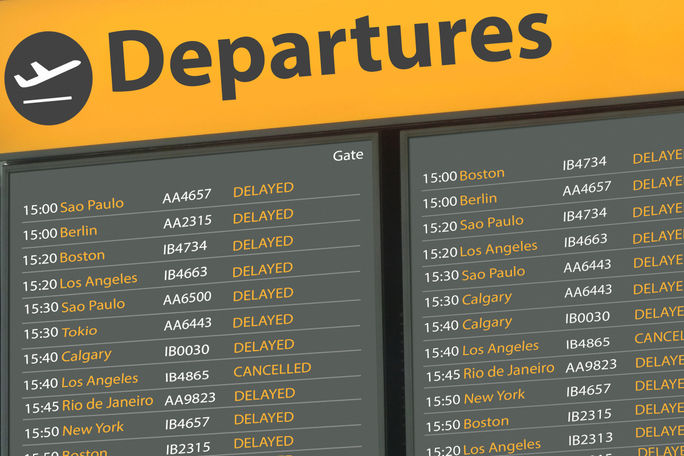
A flight delay is not only annoying, it can also have numerous other consequences.
You could miss a connecting flight or have to spend a night at the airport or in a hotel if no other flight is available. And then there are the costs of food and other necessities that come with a messed up travel schedule.
Data from the Department of Transportation (DOT) shows that about 21 percent of all flights this year arrived at their destination at least 15 minutes later than expected. Unfortunately, the data doesn’t show exactly how much later the flights arrived. The actual delays could be well over 15 minutes in many cases, perhaps even hours – but the DOT doesn’t report that level of detail.
Travel insurance marketplace Squaremouth says such delays can result in “significant financial losses” if a travel itinerary is disrupted.
Squaremouth’s data also shows that flight delays are historically one of the most common reasons travelers file a travel insurance claim, and this year was no exception. More than 25 percent of all paid claims in 2024 were the result of flight delays and missed connecting flights, according to Squaremouth. The data also shows that the average claim was about $435.
With that in mind, TravelPulse asked industry experts to share their experiences on how best to avoid travel disruptions like delayed flights and missed connections. And how to get the most out of an insurance claim when there are delays. Here’s what they had to say.
Choose an early morning flight
The experts agree on one thing: it is important to book the first flight in the morning – at least if your main goal is a trouble-free flight experience.
“Flights departing after 3 p.m. are statistically more likely to be cancelled than flights departing earlier,” says Daniel Durazo, director of external communications at travel insurer Allianz Partners, USA.
In addition to the statistics that support a punctual flight, there is another reason why early morning flights are the better choice.
“If you can catch an earlier flight, say 8 a.m., and the flight is delayed or canceled, you have a better chance of finding further rerouting options than if you book a later or last flight of the day,” Durazo continues. “If your evening flight is canceled, you could be stuck at the airport all night.”
Choose an airline with a high punctuality rate
Another valuable step to take if you want a smoother travel experience is to research the airline’s on-time history. Much of this information is available online.
“Choosing an airline with a reputation for punctuality is a good proactive strategy,” says Jeremy Murchland, president of travel insurance company Seven Corners.
According to Bureau of Transportation statistics, Delta flights were on time nearly 84 percent of the time between May 2023 and May 2024.
“That’s more than any other major U.S. airline,” says Murchland.
Hawaiian, Alaska and United Airlines also reached their destinations on time more than 78 percent of the time. Low-cost airlines, on the other hand, generally have the worst delay rates. Jet Blue and Frontier reached their destinations on time only 68 percent of the time.

Flight delays were an all too common problem in 2024. (Image credit: Courtesy of AdobeStock)
Use an app that predicts flight delays
Here’s a breaking news story. There’s an app that actually predicts flight delays. The name of the app is Flighty and it promises to help users “travel stress-free” and “predict delays.”
Wondering how accurately Flighty predicts delays?
The app’s website states: “The most common reason for delays is late arrivals, so we automatically monitor for these 25 hours before departure. The most common reason for delays is airspace restrictions, so we have direct access to the FAA to alert you – you could know before the pilot!”
Julian Kheel, founder and CEO of Points Path, says Flighty can “predict delays with surprising accuracy.”
And Kheel offers this helpful tip: “Normally you have to pay for these tools, but Flighty offers a free trial that covers your entire first flight with the app.”

Stressed traveler at the airport. (Image credit: kieferpix/Adobe)
How travel insurance can be helpful
If you’re purchasing travel insurance with the specific goal of covering costs related to missed or delayed flights, it’s important to choose your policy wisely, advises Jenna Hummer of Squaremouth.
Travel insurance covers expenses related to flight delays of 3 to 12 hours, including meals, accommodation and transportation costs.
If a delay meets these requirements, the trip delay benefit can reimburse between $100 and $5,000, depending on the policy.
But here’s the catch. When purchasing a policy, keep in mind that policies specify exactly how long a flight must be delayed before coverage kicks in. For example, some policies provide coverage for flight delays of just three hours, while others only provide coverage for delays of four hours or more, and still others require even longer delays before they provide coverage.
The point is that each policy will specify exactly when the missed flight coverage kicks in. If you want the best possible protection, it’s a good idea to opt for policies that kick in as early as possible.
“A policy that covers a flight delay of three hours is usually not much more expensive,” explains Hummer.
The advantages and disadvantages of travel insurance
When considering the costs associated with travel insurance, it’s a good idea to weigh the pros and cons of such a purchase. There are indeed benefits, but you should understand them up front.
“For me, the benefits of flight insurance are peace of mind, financial protection and the potential for significant savings in the event of a major delay or cancellation,” says Scott Faust, owner of Destinations 24/7 Travel Services.
According to Faust, the disadvantages include “the cost of insurance, limited insurance coverage with waiting periods and maximum limits on the sum insured.”
According to Squaremouth, most travelers can expect to pay 5-10 percent of the cost of a covered trip for an insurance policy. The average cost of a policy in 2024 is about $308, but this price can vary depending on trip details and the level of coverage desired.
And there’s one final disadvantage to consider: the possibility that your insurance coverage won’t be used if your flight goes ahead as planned. And that’s the goal, isn’t it?
Subscribe to the TravelPulse daily newsletter to receive the latest travel news, updates and offers.
Topics to discover in this article
Airlines and AirportsTravel Intel

